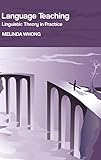Language Teaching : Linguistic Theory in Practice / Melinda Whong.
Material type: TextPublisher: Edinburgh : Edinburgh University Press, [2022]Copyright date: ©2011Description: 1 online resource (224 p.)Content type:
TextPublisher: Edinburgh : Edinburgh University Press, [2022]Copyright date: ©2011Description: 1 online resource (224 p.)Content type: - 9780748636341
- 9780748636365
- P51 .W65 2011eb
- online - DeGruyter
| Item type | Current library | Call number | URL | Status | Notes | Barcode | |
|---|---|---|---|---|---|---|---|
 eBook
eBook
|
Biblioteca "Angelicum" Pont. Univ. S.Tommaso d'Aquino Nuvola online | online - DeGruyter (Browse shelf(Opens below)) | Online access | Not for loan (Accesso limitato) | Accesso per gli utenti autorizzati / Access for authorized users | (dgr)9780748636365 |
Frontmatter -- CONTENTS -- ACKNOWLEDGEMENTS -- 1 INTRODUCTION -- 2 HISTORICAL OVERVIEW – LANGUAGE AND LANGUAGE TEACHING -- 3 LANGUAGE AS A BIOLOGICAL PROPERTY -- 4 LANGUAGE AS A TOOL FOR COMMUNICATION -- 5 IMPLICATIONS FOR LANGUAGE TEACHING -- 6 APPROACHES TO ENGLISH LANGUAGE TEACHING -- 7 PUTTING THEORY INTO PRACTICE -- 8 PRACTICE AND PRACTICES – RESPONDING TO STUDENT NEEDS -- GLOSSARY -- REFERENCES -- INDEX
restricted access online access with authorization star
http://purl.org/coar/access_right/c_16ec
How can theories of language development be understood and applied in your language classroom?By presenting a range of linguistic perspectives from formal to functional to cognitive, this book highlights the relevance of second language acquisition research to the language classroom. Following a brief historical survey of the ways in which language has been viewed, Whong clearly discusses the basic tenets of Chomskyan linguistics, before exploring ten generalisations about second language development in terms of their implications for language teaching. Emphasising the formal generative approach, the book explores well-known language teaching methods, looking at the extent to which linguistic theory is relevant to the different approaches. This is the first textbook to provide an explicit discussion of language teaching from the point of view of formal linguistics.Key featuresDeconstructs a lesson plan to show the translation of theory to classroom practiceProvides 'For Discussion' sections at the end of every chapterIncludes a Glossary of key terms and concepts in the field
Mode of access: Internet via World Wide Web.
In English.
Description based on online resource; title from PDF title page (publisher's Web site, viewed 29. Jun 2022)


